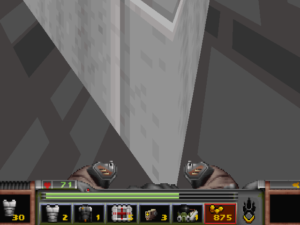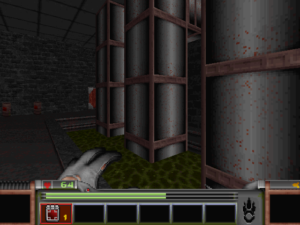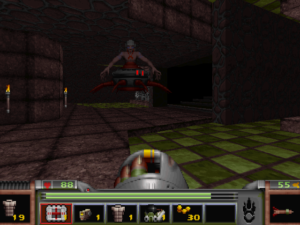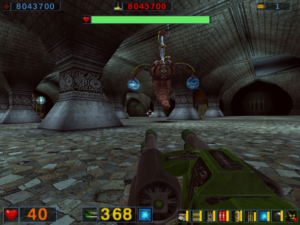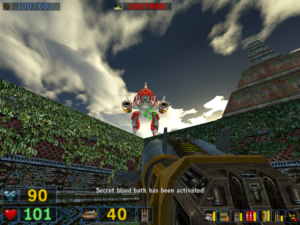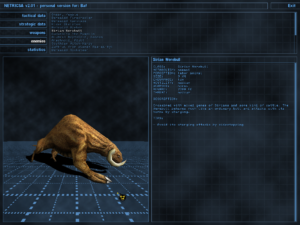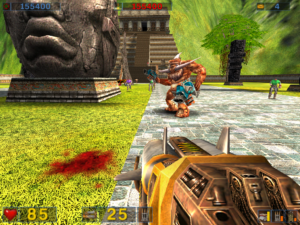I think I really have to declare TF2 to be off the stack by now, if only because I haven’t been posting about it. Completion was a difficult concept with this one from the beginning anyway. Also, I have an unofficial policy that work-related gaming doesn’t count, and arguably TF2 as I’ve been playing it fits that description. At one point, when discussing the day’s tasks with a manager, he explicitly included TF2 in the schedule. It isn’t mandatory, I objected. He replied that it kind of was: for the sake of morale, we have to take advantage of the lulls in an otherwise frenzied schedule. And, due to my machine’s illness, I’m still not playing it at home at all.
And anyway, I really have met my initial goal of playing every class for a substantial period of time. The one that I took to last was the Engineer, whose main means of attack consists of building an automated sentry gun and then sitting back and waiting. I had found it very difficult to do anything useful as an Engineer on the King of the Hill maps: sentry guns don’t last long when all the action is concentrated in one place. But we’ve been doing some Capture-the-Flag maps lately, and those are positively ideal for the Engineer. In CTF, the general pattern seems to be a raging battle somewhere in the middle of the map, with an occasional solitary player (usually a Scout) slipping through the cracks and penetrating the base where the Intelligence is kept. So there’s a place where enemies will inevitably eventually show up, and when they do, they’ll most likely be alone.
I’ve managed to get First Milestone with only one class since my last post: the Spy. It happened quite unexpectedly, when there was only one other person on the server, which makes some of the Spy’s Achievements a great deal easier. The one that pushed me over was the one you get for killing the player you’re disguised as. Well, when there’s only one other player to be disguised as, that’s not hard. I have some misgivings about this — I’ve been adamant about getting my Achievements honestly over the course of normal play, and we were just messing around at the time, not actually playing the game per se. But “messing around” is playing, no?
Anyway, I’m mainly playing Scout lately, because that’s where I’m lagging behind in Achievements. There are a couple of Achievements that you basically just get for playing a Scout for a long period of time, but most of the Scout Achievements depend on playing well, and the Scout actually requires skill to play well. Its chief strength is being able to move fast and dodge fire, which doesn’t happen automatically. (This is the opposite of the Heavy, which basically can’t dodge anything but also has less need to dodge anything.) I’ll say one thing for it, though: after you’ve played as Scout for a while, all the other classes seem unbearably sluggish. In fact, pretty much all of the classes have specific virtues that the player can acclimate to, and then miss when switching to another class; I get the impression that a lot of people just play one class exclusively as a result.
Let’s talk about the Team Fortress 2 scoring system for a moment, if only because I had a couple of paragraphs typed up already. (I was intending another “Five Things” post.) TF2 has a scoring system. (In fact, in a sense, it has two. See below.) This was not obvious to me when I first started playing, because the score is irrelevant to winning and losing. You get to see the individual players ranked by score at the end of a match, and the players on the winning team tend to have more points than the players on the losing team, but that’s because the things that get you points tend to be the sort of things that help you win, not because there’s a direct cause/effect relationship. (I can imagine a game mode in which the winning team is simply the one that scores the most points total, but if such a mode exists, I’ve never seen it.) Obviously you get points for kills, but if that were it, it would be unfortunate for the Medic. You get half a point for assisting a kill, which usually means doing damage before the killing blow is struck. Medics get credit for kill assists just by healing the person actually doing the killing. That’s a pretty good bit of design: it gives the medics a way to get points that requires them to be involved in the battle like everyone else, rather than hanging out where it’s safe and waiting for people to come to them. Some other classes also get points for being played the way the designers want them to be played when it’s difficult to do so: Spies score extra for backstabs, Snipers for headshots. Getting a Revenge kill — that is, killing someone who’s killed you three or more times — is worth a point. Working directly towards your mission objectives is worth points: capturing a control point is worth two, defending one by killing an enemy in the process of capturing it is worth one, etc. It’s all rather complicated, which is why it’s fortunate that you never actually have to think about it.
In addition to the in-game score system, there’s a fairly popular server mod called HLstatsX that tracks your lifetime performance on the server where it’s installed. It was recently installed on the server we use in our office sessions, which, since I’m still having problems with my home box, is the only place I’ve been playing lately. You can see my stats here. It tracks many things, but the one thing it makes you aware of during the game (via in-game messages) is its own point system, which persists from session to session. HLstatsX points are usually awarded for the same things as TF2 points, but in different quantities. In particular, kills yield a number of points determined by the ratio of the the killer’s and victim’s point totals; killing someone who has more points than you gives you more points than killing someone who has fewer points. At the same time, the victim loses half as many points as the killer gained. It seems like the intent here is to make the points system into something like the ranking systems used in Chess and Go, but those systems are designed to make the ranking depend solely on the player’s skill, whereas in HLstatsX, it’s not. Because the victim loses only half the points gained, killing isn’t zero-sum; each kill increases the average score. As do the points from other sources. So the number of points you have is only partly a measure of your skill; mostly it’s a measure of how much time you’ve spent playing. (When someone captures a control point, their entire team gets two points each. So it’s possible to get points just by sitting in your base and waiting.) Thus we see the variable score for killing as mainly a way to let newer players catch up to everyone else faster.
Anyway, looking at my experience of the game so far, I find that in the heat of battle, when the mind is focused on pursuing a goal, it’s easy to forget to notice the game’s absurdity. Every once in a while we try a new map, and sometimes that’s enough to bring the absurd back to my attention — many of the maps are based around rustic or decrepit exteriors as a facade over secret bases, where you can see gleaming boardrooms and computer banks just out of reach (and of course the secret bases of the two enemies are usually separated by just a few dozen yards) — but sometimes it actually takes me a while for this to penetrate my consciousness, which is otherwise occupied with trying to figure out the lay of the land. But I suppose that it all affects the experience of the thing even if you’re not paying attention to it, as architecture always does. (Are there people with training in architecture working in level design? It seems like a relevant skill.) And besides, the developers have made it clear in commentary and interviews that they, too, put the gameplay first and the absurdity second — that, in fact, the absurdity was developed as a way of enhancing gameplay. The bases are unrealistically close together because that makes for a better game, and once they do that, they might as well play it for laughs rather than make excuses for it. The broad caricature in the character design was adopted to make it easier to recognize different classes from a distance. Rocket-jumping was inherited from Quake , where it was an unintended consequence of the physics model, and didn’t really fit the fiction; in TF2, it comes off as not just unrealistic but downright cartoony, which makes it fit in perfectly. I was recently shown a Youtube video of a Demoman using explosions to launch himself long distances like a missile. There are similar videos for other games — Halo alone seems to have dozens of “Warthog Launch” videos, where players try to get a vehicle up on top of an unnavigable cliff by detonating a piles of grenades under it — but this is the first time it’s seemed like a legitimate part of the game, and a viable tactic.
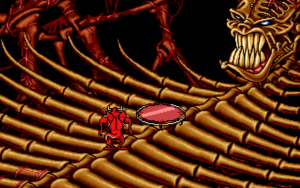 I’ve finally reached the trampoline room.
I’ve finally reached the trampoline room. Comments(2)
Comments(2)